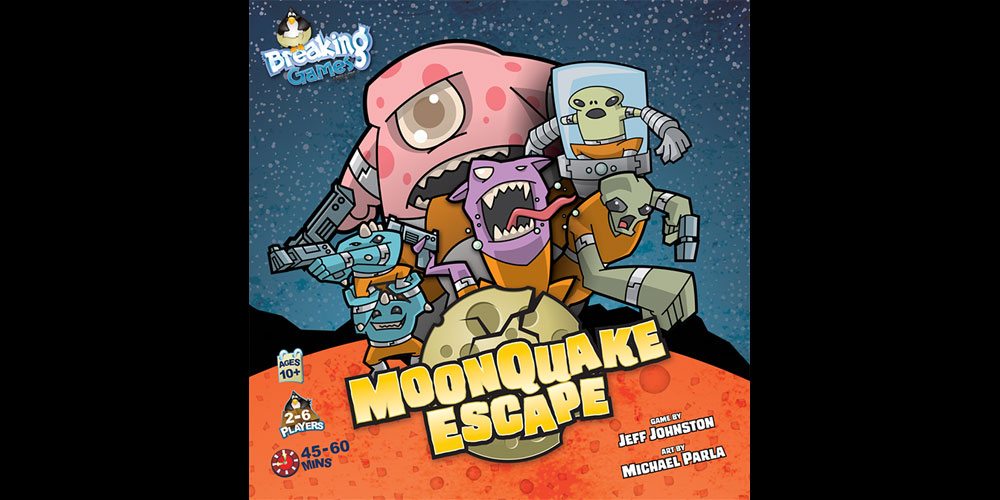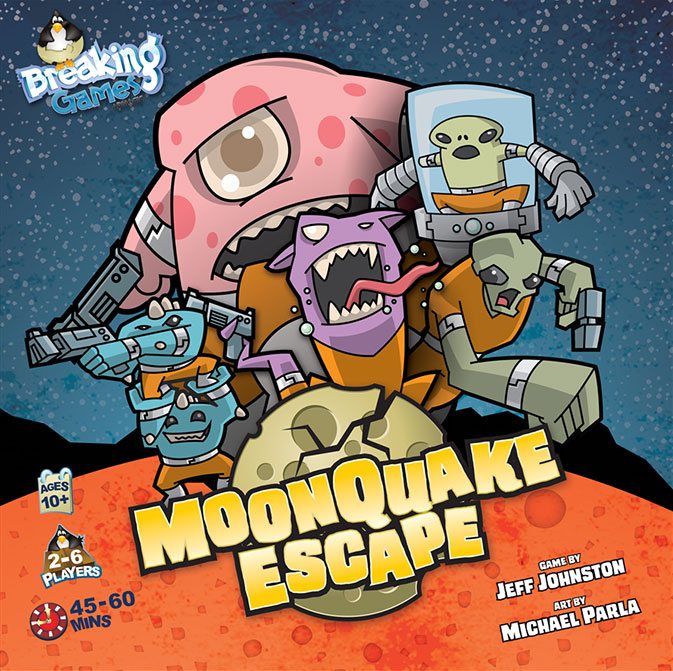The planetoid Zartaclaton is a prison for the worst criminals—but the engineers didn’t anticipate the gravitational stress of the erratic moon. The giant MoonQuake sets you free—can you make it to the last rescue rocket before the other aliens?
At a glance: MoonQuake Escape is a game for 2 to 6 players, ages 10 and up, and takes about 45–60 minutes to play (though expect 6-player games to last a bit longer). It retails for $59.99 and is available online from Amazon or directly from Breaking Games, as well as in game stores. The game is a mix of action management and a bit of a shell game as you try to stay hidden. Basic and Advanced modes of play make it good for a wide range of ages, though players should be comfortable with direct attacks.
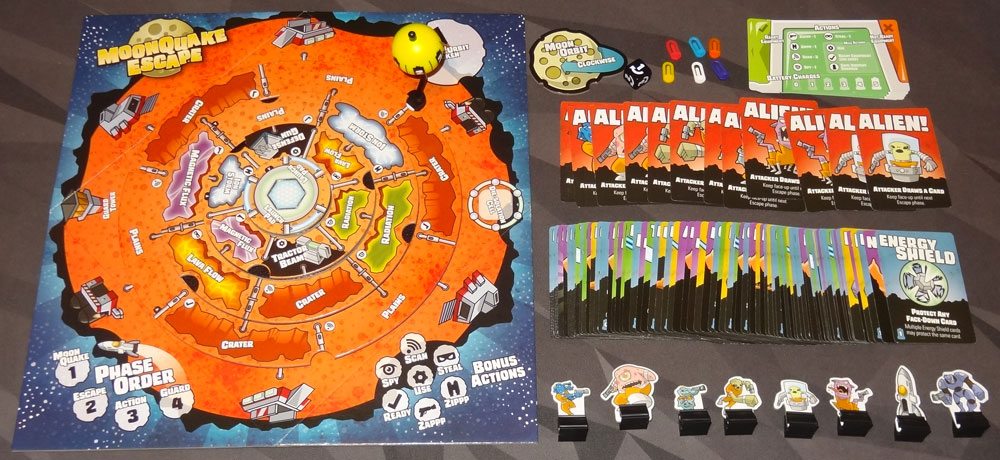
Components
- Prison gameboard:
- Board
- Unstable Molten Core
- Gravitation Stress Arm
- Moon spinner post
- Moon spinner
- Base structure
- 3 Double-sided Surface Rings
- Double-sided Launch Pad
- Moon Orbit token
- Quake die
- Guard pawn
- Rocket pawn
- 6 Alien pawns
- 6 Status cards with clips
- 87 cards
- Phase token
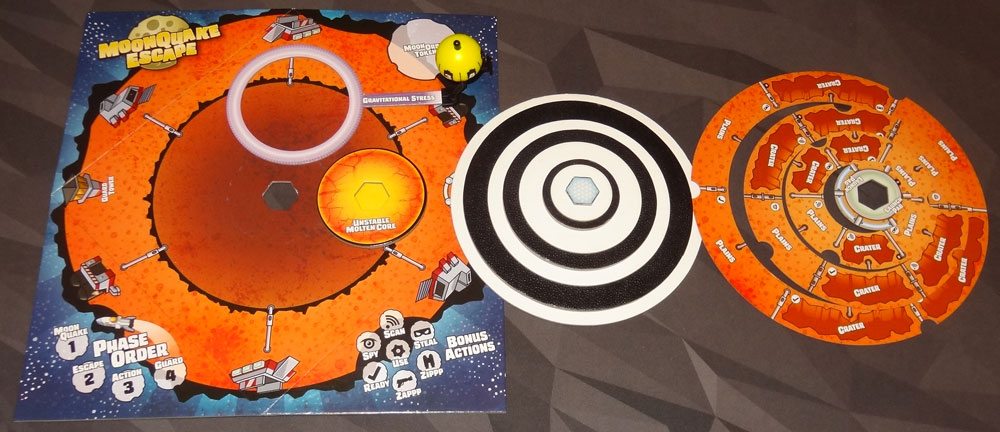
The most interesting component in MoonQuake Escape is the board itself, which (as you can see from the components list) is actually made up of several pieces. At the bottom is a board with a hexagonal hole in it—the corners of the board fold in so that the center is a solid piece. The “Unstable Molten Core” fits into that, and the “Gravitational Stress Arm” is a cardboard ring that fits over that. There’s a plastic piece that clips to the end of that to hold the Moon Spinner. The base structure is several layers of discs of decreasing size, with a hex-shaped plug on the very top and the very bottom—the bottom one fits into the molten core. Finally, there are four more pieces (three surface rings and a launch pad) that fit onto the base structure.
The surface rings can be turned, but the launch pad is fixed. I will note that some of the rings fit pretty tightly on the base structure, so they don’t all turn easily. There are some finger notches in each ring to help with the turning, and it’ll loosen up a little over time, but when it’s brand-new it can be a little sticky. The surface rings and the launch pad are all double-sided, with a Basic side and an Advanced side. There are pipes on the rings that help you line up the rings and also divide the rings into separate spaces. I like that the molten core and the gravitational stress arm are labeled and decorated even though they’re both completely covered up by the base structure during play.
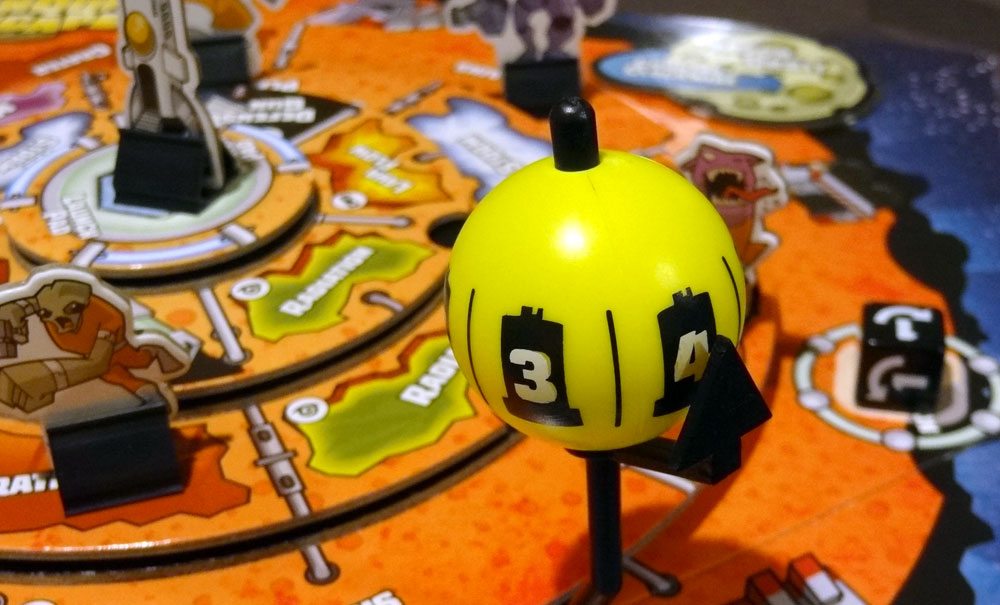
The Gravitational Stress Arm extends out to the edge of the base structure, and it can be rotated around to face the active player. It’s one of those things that isn’t absolutely necessary (you could just pass a die around) but it’s a pretty cool thematic gimmick that illustrates the moon behaving erratically. The moon itself is like a ping pong ball with a hole through it, with numbers painted on the sides. The arm has a little arrow piece to mark your spin result.
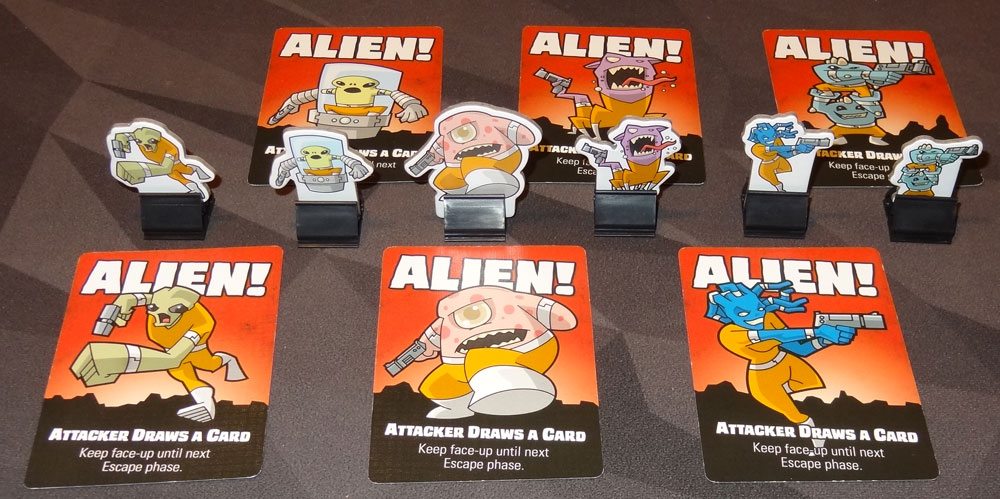
The illustrations on the game, by Michael Parla, are fun—everything has big, bold outlines and a cartoony look. I like the variety of aliens, plus the fact that they’re all wearing orange jumpsuits of some sort.
The cards themselves are pretty good quality—linen finish, and easy to shuffle. All of the pawns are cardboard punch-outs with plastic stands, and they work fine, too. The only complaint I have about them is that there isn’t enough extra blank space at the bottom of the pawns, so the illustrations get partially obscured if you put them all the way down into the stands.
There are little plastic clips that attach to the status cards to show your current battery level. They work all right, but are a little loose so you have to be careful not to knock them off while playing.
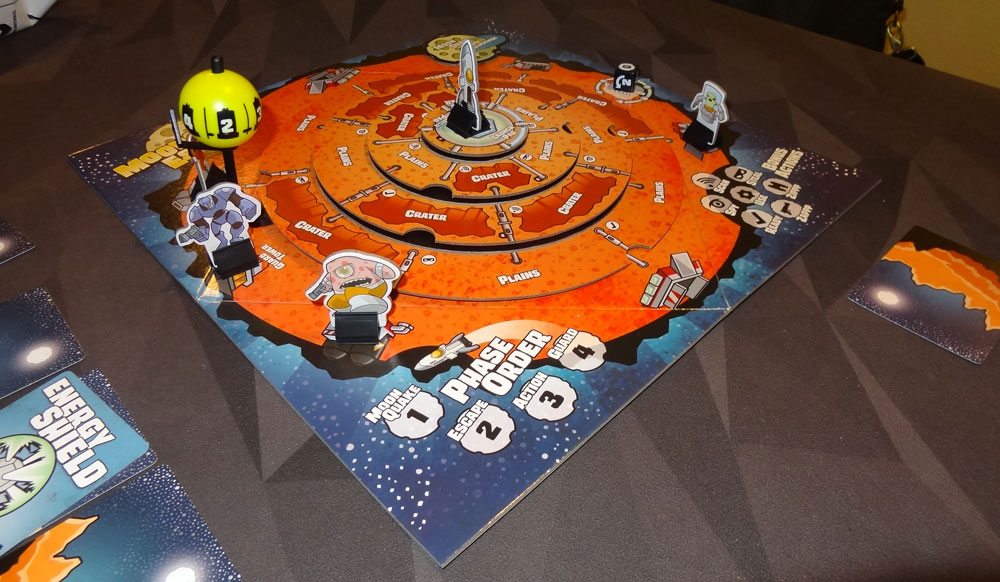
How to Play
There are Basic and Advanced rules—I’ll explain the Basic first, and then explain the differences for Advanced.
The goal of the game is to reach the launch pad and escape in the rocket—you must be on the launch pad, be hidden, and have at least one battery power left to launch the rocket.
To set up, assemble the board and place the die in the “Die-solation Cell,” place the Moon Orbit token on the orbit space set to clockwise, place the rocket on the launch pad, and place the guard pawn on the Guard Tower space. Each player gets a status card and clip, an alien pawn and the two alien cards matching the pawn, an Energy Shield card, and 4 more cards from the deck. You start with 0 battery power (marked with the clip). Tuck one alien card under your status card—that’s just so everyone knows which alien you are—and your pawn on any of the exit spots along the outer edge of the board.

You place any (blue) equipment cards you were dealt on the right side of your status card (where it says “Not Ready Equipment”), and the rest of the cards are placed face-down in front of you, along with your Alien card. Then place your Energy Shield face-up on top of one of your face-down cards. The face-down cards are referred to as your “hand,” though they remain on the table and you don’t actually hold cards in your hand.
Now you’re ready to begin! Spin-off to see who’s the first player, and use the winning spin as the starting spin for the first turn. Rotate the Moon Spinner around so that it’s facing the active player.
Each round has several phases (shown on the board): MoonQuake, Escape, Actions, and Guard.

MoonQuake: First, resolve any Reverse Orbit cards that may be in play. Then, spin the Moon Spinner unless there’s a Lunar Event. Everyone gets battery equal to the amount shown on the Moon Spinner, marking it on their status cards. Then, the active player rolls the quake die three times, one for each level. The quake die will show a number and a direction—turn the rings that many spaces.
Escape: If you’re hidden (your alien card is still face-down in your hand), you move up one ring into one of the two available spaces. Note that you can’t move into a crater space unless you have the right equipment, or if you have no other choices.
If you’re exposed (your alien card is face-up in your hand), you draw 3 cards (or 4 if you’re on the launch pad), and then turn your alien card face-down.
Then, each player may rearrange their hidden cards, and move ready energy shields to protect them.
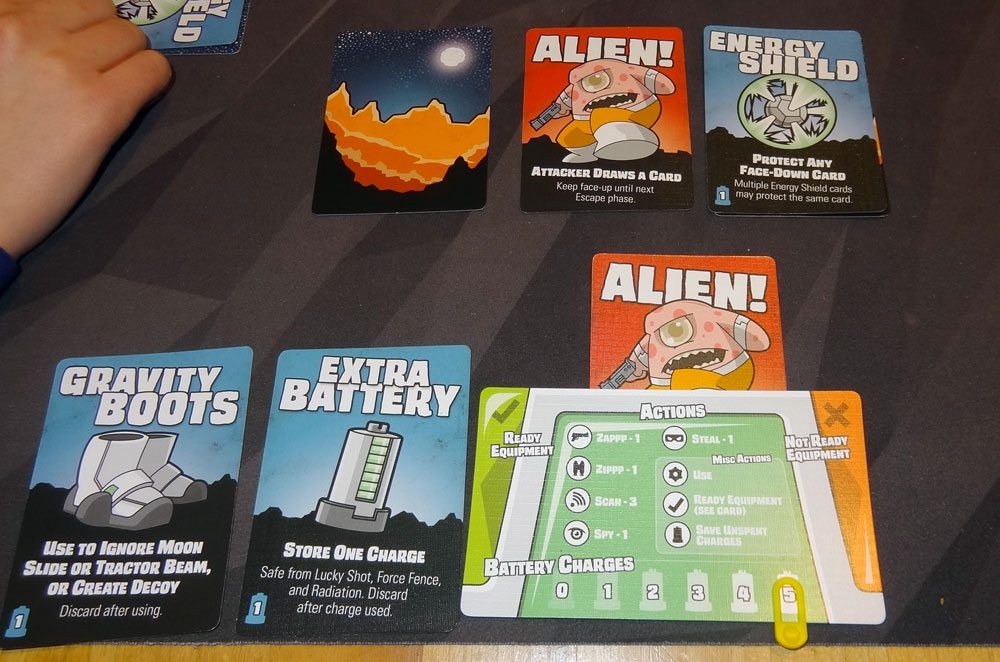
Actions: This is the bulk of the game—you spend your battery points on various actions. You also earn one free action based on the space where you start your turn. (If you move to a different space, your free action does not change until the next round.)
- Zappp (1 energy): Expose and resolve one hidden card in another player’s hand, or move the guard to the guard tower. (You may only Zappp players whose alien cards are still hidden.)
- Zippp (1 energy): Move up to 2 spaces on your current ring.
- Ready: Spend the energy shown on an equipment card to move it from Not Ready to Ready. Once Ready, you may use any equipment for free by discarding it.
- Spy (1 energy): Secretly look at one hidden card in another player’s hand. You may not look at cards protected by Energy Shields.
- Steal (1 energy): Take an unready equipment card from another player in your space.
- Scan (3 energy): Draw a card from the deck. Equipment is added to Not Ready, and other cards are placed face-down. If you add a card face-down, you may rearrange your hidden cards.
You do not have to spend all of your battery, and anything unspent carries over to the next round.

When you Zappp a player and expose a card, there are various effects that may happen. Green cards are reactions that are bad for the attacker. Yellow cards are bad for the defender. There are purple cards which have a moon-based effect, so it will affect all players. And there are also “Nothing” cards. The worst, of course, is if your alien card is revealed—the attacker gets to draw an extra card immediately, and you’re exposed until the next Escape phase.
Guard: If there are aliens on the guard’s current level, it Zappps every alien on that level. When the guard Zappps a player, the next player in turn order chooses a card to Zappp—the card is discarded with no effect. If there were no aliens on the guard’s level, the guard moves to the next higher level.
At the end of the guard phase, check to see if anyone won. To win, you must be on the launch pad, your alien card must be hidden, and you must have at least one battery charge. If multiple people are able to launch, the player with the most face-down cards wins. If there’s still a tie, then you spin-off for the win. If nobody won, rotate the Moon Spinner in the direction of the moon orbit and start a new round.

Advanced Rules
There are a few advanced rules—you can add any number of these rules as you like.
Advanced Guard Movement
Now, if the guard would go up a ring, the active player chooses any space on the next level, places the guard there, and then rolls the quake die to move the guard. The guard will then Zappp all players in its space. (The guard still behaves normally if there were aliens on its level at the beginning of the guard phase, Zappping all players on its level.)
Aiming
You may now move freely in and out of craters, but when you’re in a crater you are no longer able to use Zappp or Spy actions except on players who are in the same crater. Likewise, you cannot be targeted for Zappp or Spy except by players in the same crater. Aiming rules affect the Guard, Defense Gun, and Tractor Beam, too. If the guard can’t see anyone on its level (because they’re all in craters), then it moves up as if the level were empty.
Hidden Equipment
You may now place newly drawn equipment cards face-down in your hand instead of in the Not Ready area. Once it is placed, you may not bring it back to Not Ready. If it is the target of a Zappp, the attacker takes it and places it as Ready. (Equipment cards gained by Zappp or Steal must be placed face-up.)
Decoys
You may use a Repair Kit to convert a ready Hazard Suit or Gravity Boots into a face-down card in your hand. These are then subject to Hidden Equipment rules.
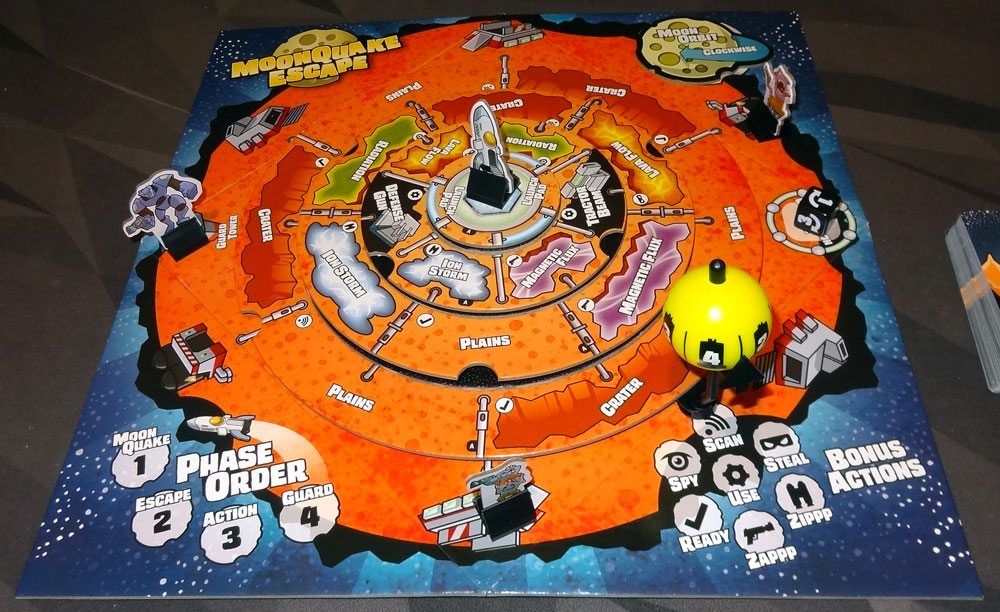
Terrain
If you flip over the rings, you’ll see a lot of new terrain types besides the plains and craters in the basic game. The force fence around the launch pad (which costs you a battery charge when you cross it) has a slightly different configuration. Some of the terrain has an immediate effect when you step on it, and some has an ongoing effect.
- Crater: Lose 1 charge during the MoonQuake phase.
- Magnetic Flux: Shield cards are moved to Not Ready when you enter; you may not ready Energy Shields.
- Lava Flow: All unready equipment is destroyed when you enter, and cannot be saved with the Repair Kit.
- Radiation: Your battery level goes to 0 at the end of your action phase.
- Ion Storm: Cannot Scan or Spy, but you’re also safe from Spy actions by other players.
- Defense Gun: You get Zappped when you enter; you get a free bonus action to Zappp any player (including exposed players) or the guard.
- Tractor Beam: You get thrown when you enter—roll the quake die and move that many spaces; you get a free bonus action to use the tractor beam on another player or the guard.
Sudden Death Shootout
If two or more players were tied for the win with the same number of face-down cards, there’s a sudden death shootout instead of spinning for the win. The tied players may rearrange face-down cards and Energy Shields. If the guard was already on the launch pad, move it to the guard tower.
Starting with the active player, do the following: The current player gets 1 charge and may take actions against other players. If a guard card is turned up after a Zappp, the guard pops in, Zappps everyone once, and then goes back to the guard tower. (If this eliminates all players simultaneously, nobody wins.) If a Stasis Gun Jam is revealed, the attacker may not Zappp until the next round of the shootout.
You are immediately eliminated if:
- Your alien card is revealed.
- You run out of charges (including Extra Battery cards).
- You get knocked off the Launch Pad.
The last player standing wins.
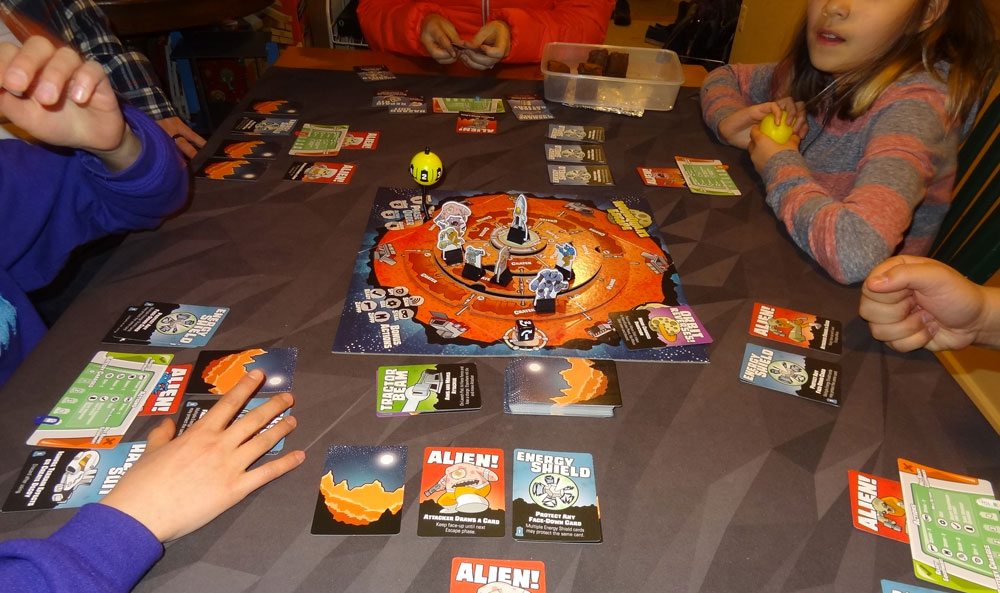
The Verdict
I’d first come across MoonQuake Escape at Gen Con (maybe 2015?), where designer Jeff Johnston was running demos of it, and I was always impressed by both his enthusiasm and his ability to explain the gist of the game concisely. It’s great to see the finished game finally, and it is a lot of fun.
The shell game aspect is a key part of the game: you can’t launch the rocket unless you’re hidden, and you can’t stay hidden if you don’t have enough cards to mix up. The energy shields can be used to protect cards (and can even be stacked)—but, of course, you don’t have to use that on your alien card, because that would be too obvious, right? You have to keep other players guessing.
I like the mix of cards that might get revealed when somebody Zappps another player, because that also plays into the decision. Sometimes you get yellow cards, allowing you to take another shot or drain the target’s battery power; sometimes you get green cards, which are bad for the shooter. The Spy action lets you peek ahead at a card, so you can take aim more carefully—but of course then you can’t shoot as often. That’s another nice choice you’ll make throughout the game: do you want to be cautious or quick?
The moon can be a little bit chaotic—the more shooting that’s happening, the more likely that a “reverse orbit” card may turn up and mix things up. In our 6-player game, there was a long stretch where the start position bounced back and forth between three people and the other three never got to go first. That could be somewhat frustrating if you really wanted to go first, or really funny if you’re okay with unpredictability.
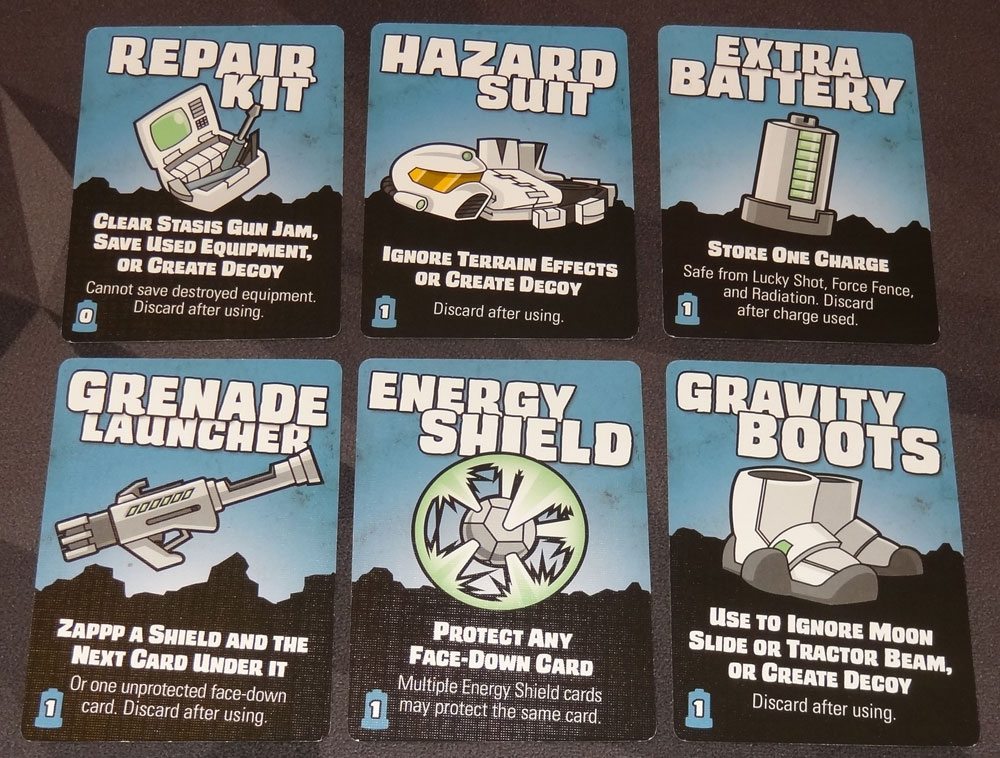
The basic rules are fairly simple but still allow for that shell game aspect. The game marches toward the end condition, since aliens who aren’t caught move up, and the guard advances steadily as well. There aren’t many ways to be pushed back down, so you mostly just need to stay hidden and you’ll eventually make it to the launch pad. Once there, though, you’ll definitely be the target of everyone else, so you’ll have to budget your battery power wisely—use enough to protect yourself, but you have to save at least 1 battery to launch the rocket, so that effectively puts you at a disadvantage from anyone who isn’t on the launch pad yet.
The advanced rules really throw in a lot more options and add to the strategy. The new terrain is the most apparent change—you can now hide in ion storms so other players can’t spy on you, or take a chance on the tractor beam yourself in order to toss another player around. But aside from the new terrain, some of the other new rules create some really interesting decisions for players. For instance, the decoy and hidden equipment rules both let you use equipment face-down in order to get more cards to hide your alien. The downside, though, is that if somebody Zappps it, they get to take it and it’s already ready! So you have to balance the cost of staying hidden with the cost of giving an opponent more equipment.
The advanced guard movement rules can be tricky, too. The active player gets to choose which space to move the guard into when it goes up a level, and then rolls the die to see which space it will move to. Do you move it to your own space, since it’s most likely that the guard will move at least one space? Or do you move it as far from you as possible, hoping that you roll low? It’s harder to target a particular player with the advanced movement, but I like that it doesn’t simply attack everyone on the level—there’s more room to hide from the guard this way.
I already mentioned a few of my complaints about the game—mostly having to do with the components. The rings don’t spin as freely as they should, and the little clips for the battery level are fairly loose and slide off easily. The die and the spinner are both screen-printed instead of engraved or molded, so I imagine that might wear off after extended use. That said, the design and construction of the board is pretty outstanding, so I’m willing to make some allowances here and there because of the board’s innovation.
Overall, I’ve been enjoying MoonQuake Escape and so have my kids. I’ve played it with both kids and adults (and both together), and it’s a mix of luck and strategy, so you can get better with practice but you can also get some lucky shots as a novice. The hidden alien card adds a nice psychological element as you try to deduce (or just guess) where everyone is hiding their aliens. I like that the game fits up to 6 players, too—it means I don’t have to rule this out just because I have a few more show up for game night.
Buy a copy online, or look for it at your local game store!
Disclosure: I received a review copy of this game.

